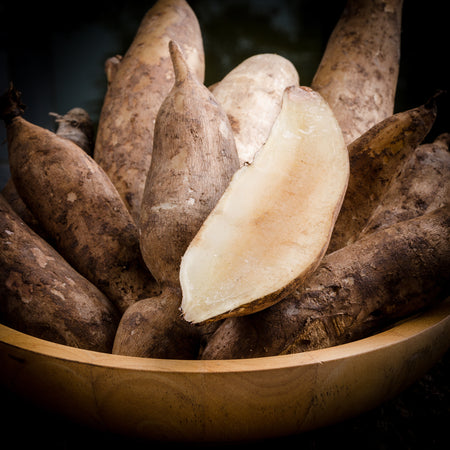YACÓN
Product Description:
Yacón plants ship late March in 3 ½ inch containers. Available only within the contiguous US.
| Plant Spacing | 3-4' |
Smallanthus sonchifolius
Initial Instructions
After unpacking, allow the plant a few days to gradually acclimate to full exposure. If there is still a threat of frost, keep the plant on a sunny windowsill. Select a location in full sun with well-drained soil that’s rich in organic matter, spacing the plants 3-4 feet apart. Offer protection from high winds.
Cultivation
Yacon is a relatively easy and forgiving crop. Water regularly during the growing season. Fertilize lightly at planting time with a high-potassium source such as seaweed, wood ash or greensand. Its nitrogen and phosphorus requirements are moderate, so no additional fertilizer should be required as long as there is sufficient organic matter in the soil. Keep the area around the plant weed-free. As the roots develop, they may protrude from the soil surface; mound more soil over them to protect the developing roots from slugs or other pests. Plants are heat tolerant but may require more water during hot spells. Small sunflower-like blooms will appear in fall.
Harvest
Allow the plant to die back from frost. Gently loosen the soil in a 24 inch circle around the plant and lift the crown with its roots using a digging fork. Brush off excess soil and allow the roots to sweeten up on a sunny windowsill for 2 weeks. If you live in a frost-free climate, you can harvest your crop after about 5 months in the ground or wait until you see the plant starting to naturally fade. Save the crown and rhizomes with a few roots attached to re-plant next spring. Store in dry sand at around 40°F. About a month before your last frost, divide the crown, leaving at least 2 ‘eyes’ on each division. Pot the divisions in 4-6 inch pots, and allow them to grow indoors until the last threat of frost has passed. Transplant outdoors as directed above.
Size at Maturity
4-8 feet tall depending on conditions.
Pests & Diseases
Yacon is generally pest and disease resistant, but can be bothered by the same pests that favor sunflowers, since they are related.
Soil Type
Well-drained soil high in organic matter.
Light Requirements
Full sun to part shade.
Harvest Time
Autumn


